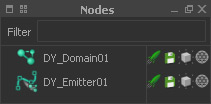
Dyverso fluids are mainly used for small- or mid-scale projects. If you want to simulate huge volumes of water with splashes, foam, and bubbles, we recommend using RealFlow's Hybrido technology.

In the → "Learn" section you will find tutorials about how to stop particle emission, fill objects, multiple domains and emitters, how to achieve emission from objects, and more.
Setting up a Dyverso fluid scene requires just a few steps – the parameters are available under → "Node Params":

Dyverso fluids always consist of a domain and an emitter:
Dyverso fluids are → GPU-accelerated and they are able to
To switch between the various materials and particle types go to DY_Domain > Node Params > Particles > Type.
Dyverso supports the interaction of particles from → different domains and different materials. Here is a table with all possible interactions:
| Liquid-SPH | Liquid-PBD | Granular | Viscous | Viscoelastic | Rigid | Elastic | |
|---|---|---|---|---|---|---|---|
| Dumb |  |  |  |  |  |  |  |
| Liquid-SPH |  |  |  |  |  |  |  |
| Liquid-PBD |  |  |  |  |  |  |  |
| Granular |  |  |  |  |  |  |  |
| Viscous |  |  |  |  |  |  |  |
| Viscoelastc |  |  |  |  |  |  |  |
| Rigid |  |  |  |  |  |  |  |
| Elastic |  |  |  |  |  |  |  |
| Dumb | Ballistic particles, unable to interact. Good for massive spray effects. |
|---|---|
| Liquid - SPH | "Smoothed Particle Hydrodynamics". A highly accurate fluid type similar to RealFlow's standard particles, but much faster, and GPU-accerlated. |
| Liquid - PBD | "Position-Based Dynamics". A very fast and robust fluid type. |
| Granular | Suitable for the simulation of sand, snow, salt, and other granular substances. |
| Viscous | Used to simulate substances like honey, cream, tar, caramel, syrup, etc. |
| Viscoelastic | Good for ketchup, toothpaste, or silicone. |
| Rigid | Simulate → rigid bodies based on particles. |
| Elastic | Simulate → elastic bodies with the help of particles. |